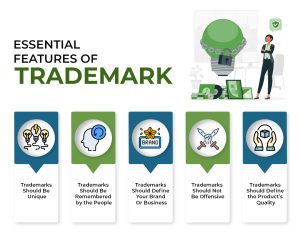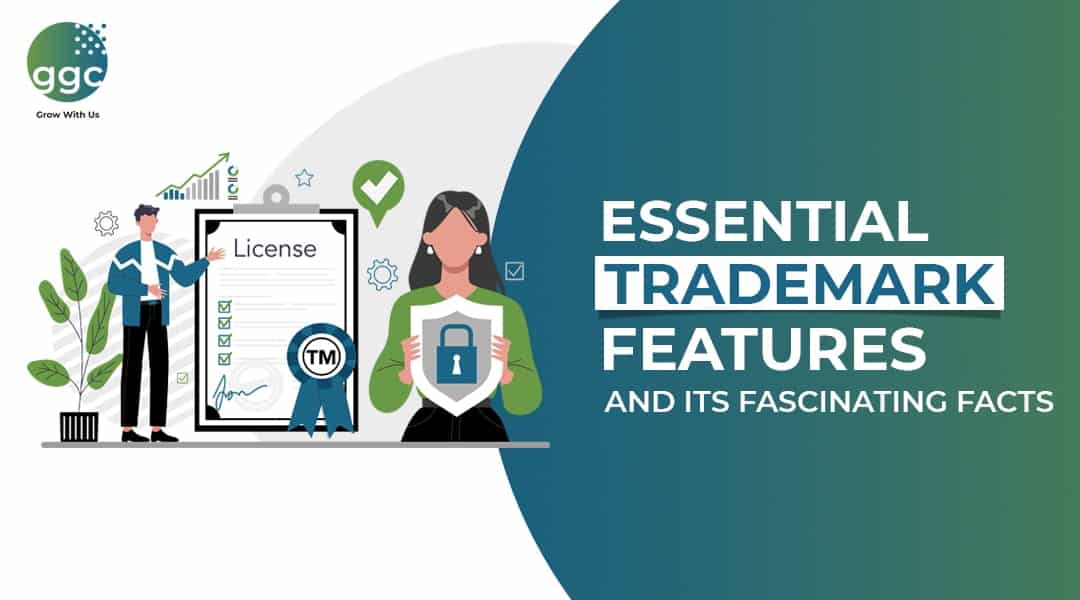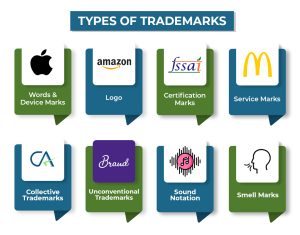A trademark, as the name suggests, is a mark or symbol of your enterprise or business for easy and quick recognition by people. This symbol can be a unique product logo, brand name, or any creative expression that exclusively identifies your business.
But what if a competitor starts using the same symbol or brand name to break into your customer base? The trademark law establishes your right to use your trademark (an intellectual asset created by you) and prevents others from using the same.

Your trademark might be at risk
As your business grows, it chisels out a place for itself in the marketplace. The stray and one-time customers slowly turn into repeat or loyal customers, recognising your product and company. This is a very crucial stage in the life cycle of a business, as companies start investing in developing and advertising logos, symbols, brand names, etc. to earn people’s faith and confidence.
But your growth is being watched by others in the same trade, and some might try to harm your goodwill by distributing inferior products with your logo or symbol embossed. Trademarking acts as an essential tool to defuse such risks. In this article, we’ll go deeper into understanding the scope of the trademark in India.
Trademark ideas
A trademark may be made on logos, images, words, slogans, colours, shapes, a single word, or a combination of some of these. Words and pictures are the most widely used distinguishable markers. However, other distinguishable marks may also be used if they can be represented graphically.
For example, the giant conglomerate Tata Sons has both word and symbol trademarks.
Cadbury, the top chocolate brand, has the colour purple trademarked for its chocolate wrappers. Coca-Cola owns a trademark for the design of its bottles. The Golden Arches of McDonald’s are an example of colour and shape trademarks. Facebook’s trademark logo is a colour and the letter ‘f’ in a unique font. Fevicol is a brand and logo trademark.
Sometimes, the terms trademark and brand are used interchangeably. But whereas a trademark is not always a brand, a brand should always be trademarked. A trademark is also seen as a marketing instrument that helps protect the company’s interests and generate revenues.
The Trade Marks Act, of 1999 of India addresses all legal acts and formalities relating to trademarks, including registration, protection, and remedies in the event of an infringement. Because India is a signatory to the Paris Convention and the TRIPS agreement, the Act complies with its principles.
Trademark vs. Brand
While a brand represents the intended impression of your company, it also becomes an intellectual property. A trademark protects your brand. Likewise, it can protect many other intellectual properties. Many companies use a trademark to protect a specific aspect of their business, such as their company name, slogan, or emblem.
If you merely have a trademark and put no more effort into your brand, your company may struggle to enter markets in a meaningful way. Similarly, if you solely focus on branding and lack solid, protectable trademarks, another company might steal your brand and opt for trademark protection of the same.
Understanding the differences between trademarks and brands and accounting for those variances while creating your business will give your organisation a better chance of success.
TYPES OF TRADEMARKS
A trademark can be classified into the following types:
- Words in italics: They could be words, letters, or numbers. COCO CHANNEL and APPLE are two examples.
- Device marks: These are the exclusive depictions of a word, letter, or number. For example, the way Amazon or eBay are written
- Figurative marks or logos: These are made of a figure or a logo. For example, the yellow M of McDonald’s or the SWOOSH symbol of Nike
- Service marks: A service mark distinguishes a company’s services (rather than things) from those of another. For example, McDonald’s has a series of product lines (McChicken, McVeggie, etc.) that use the prefix ‘Mc’ to link their product and service quality connotation to the parent McDonald’s
- Certification marks: Standards are defined using certification markings. They reassure customers that the product meets specific requirements. For example, the ISI and FSSAI marks
- Collective Trademarks: These trademarks are associated with a group of people rather than a specific product or service. These trademarks are largely owned by an association, institute, or group. Members of the association can use the trademark logo to be identified with that association
A chartered accountant, for example, can use the “CA” logo since he is a registered member of the Institute of Chartered Accountants.
Unconventional Trademarks:
Unconventional trademarks are the ones that are recognised for their naturally distinguishing features:
Cadbury Chocolates owns the purple colour trademark.
Sound Notations: The Hemglass ice cream van jingle is a well-known sound trademark.
The Coca-Cola bottle has 3D markings.
Smell Marks: In June 2015, the Brazilian footwear brand Grendene successfully patented their range of bubble gum-scented jelly sandals.
Purpose of a Trademark
A trademark is usually used to identify the origin or source of commodities, products, or services. A trademark in India serves the following purposes:
- It identifies the product as well as its origin
- It proposes to guarantee the product’s quality
- It advertises the goods by representing them
- It develops a mental image of a product in the minds of the general public, particularly users or prospective consumers of the product
Let’s be more specific.
Product Differentiation
Trademarks are the most basic means of differentiating a product or service. Trademarks allow a client to identify items, products, or services in the market and make an informed purchasing decision.
In perfect competition, a buyer’s perfect choices are trademarked services or products from many suppliers. However, in the context of product differentiation competition, such trademarked services or products are only close equivalents. The competition is based on the non-substitutability of the services or products in terms of brand loyalty and advertising efforts.
For example, Surf, RIN, and Ariel are the three leading brands of detergent. They trademark their logos to differentiate their products from one another. So when a buyer asks for a specific product, say Surf, she means Surf only and not any detergent.
Identifying the Source of Origin
To the consumer or end-user, the trademark ensures the identity of the origin of the trademarked services or commodities. It allows the consumer to differentiate trademarked goods or services from others of a different origin without being confused. Only if the brand is distinctive is it eligible for registration and protection under Indian trademark law.
The Trademarks Act further protects the trademark by prohibiting any identical or similar use of the trademark by competitors in the market who may take advantage of the trademark’s reputation and position.
For example, the trademark ‘Brooke Bond’ indicates tea produced by a company that markets tea under that brand.
Quality Differentiation
A trademark assures clients that the items or services bearing the trademark are of high quality. Customers choose high-quality items or services. Thus, trademarks assist buyers in deciding which things to acquire or which services to use. The fundamental characteristics of trademarks are reputation and quality identity.
For example, the quality of tea sold in the packs trademarked as ‘Brooke Bond’ would be the same, but they would be different from tea tagged with the trademark ‘Taj Mahal’.
Advertising
Another important role of trademarks is to serve as an effective form of advertising. The goal of trademark usage is to raise consumer awareness of the trademark and draw their attention to the branded items or services. Advertisements that reinforce the image of a product or service might attract customers.
For example, the ‘Sony’ trademark is connected to electronic products. It promotes the brand while separating it from Sony’s competitors’ products.
Creating a Positive Image
Trademarks aid in the creation of a positive image of the product or service with which they are connected, as well as goodwill for the company. A company’s intellectual property or asset is the goodwill represented in a trademark.
A company’s long use of a trademark causes the general public to become aware of the trade name or brand name and identify the particular trademark with specific services or items.
For example, the mark ‘M,’ which signifies food items originating from the American fast-food chain ‘McDonalds,’ develops a reputation and image for food items sold in the market by it.
Benefits of a Trademark
There are many benefits to a trademark and its registration; a few include:
- A trademark identifies the products and/or services and their owner or origin.
- A trademark provides the trademark owner with the right to use the trademark throughout the country.
- Trademark registration provides the enterpriser with the right to use the mark in respect of the merchandise or services covered by the trademark.
- A trademark is an associate degree that is intangible, and it may be pledged as security so as to get loan facilities.
- A trademark is cost-effective, and it takes from around 6 months to 2 years to process the application and get the trademark registration completed.
- A trademark, upon registration, may be oversubscribed, licenced, or appointed and might even be transferred.
A Few Facts about a Good Trademark that Should be Considered before Trademark Registration
- A trademark should be easy to say and spell. A trademark is considered better when the public can easily spell and speak it
- A trademark should be catchy and easy to remember. So that it becomes easy for the public to remember their brand
- It should not be complicated. If the trademark is complicated, people will not bother to memorise it, and ultimately it will be forgotten
- It should be appealing in both sound and appearance. The best trademarks are words, symbols, or unique geometrical designs
- It should allude to the product’s good characteristics
- It must be distinctive, i.e., distinguishable from other trademarks in the same class
- It should be easily related to the things that it represents
- It must be registrable and protected
How to apply for Trademark Registration?
- The application for trademark registration can be filed with the Trademark Registrar.
- The application must be made in the prescribed manner and filed along with the fee for trademark registration.
- A trademark registration application must contain the following information:
- Logo or the trademark
- Name and address of the trademark owner
- Classification or trademark class
- Description of the goods or services.
- Once the application is filed with the Trademark Registrar, a trademark application allotment number is provided within one or two working days, after which the owner of the trademark can affix the trademark symbol (™) next to the logo.
- Once there are no objections or oppositions to the trademark registration application, the trademark manuscript and a trademark registration certificate will be prepared and sent to the trademark application.
- Once the trademark registration certificate is issued, the trademark is considered to be a registered trademark of the owner, granting the trademark owner exclusive use of the mark.
How can a Trademark help a Business?
Trademarks are valuable corporate assets, and although registration is not compulsory, it is recommended because unregistered trademarks receive little protection. If another business tries to use the same or a similar mark after registration, there will be a suitable legal procedure to block it.
A trademarked name distinguishes the proprietor’s product or service from those of others, and it also protects the proprietor’s reputation from damage due to counterfeit products. A trademark is valid for ten years and can be renewed indefinitely if further payments are made. Trademark rights are private property rights that are enforced through judicial orders.
Trademark piracy is defined as the use of a trademark by unauthorised or unlawful means in trading. If there is a trademark infringement, the owner of the registered trademark can take legal action, whereas the owner of an unregistered trademark in such a situation can’t expect any favourable consequences.
Conclusion:
It is a well-established legal provision that a business can obtain to secure its exclusive rights to use a mark or symbol as its trademark. A trademark greatly serves to establish confidence in the brand, thus creating brand loyalty.
A trademark also safeguards the goodwill and reputation of a business from malicious competition. Without the protection of a trademark, the growth of a business is always vulnerable, as other companies in the same field may find it easy to steal the identity symbol of your business and harm your goodwill by providing inferior products to your customers.
Therefore, you should be smart enough to use a trademark as a tool for the growth of your business, both for improving your brand value and, on the other hand, for protecting it from poaching.
Trademark registration is a must to stand out from the competition in the market & as a Top Finance Company provides the best solutions in Trademark Registration.
Trademarks are an important part of any business, but they’re not the only factor that determines financial success. A strong financial foundation is essential for any business to thrive. Our short-term finance course can teach you the financial skills you need to succeed, regardless of your industry or business size.



